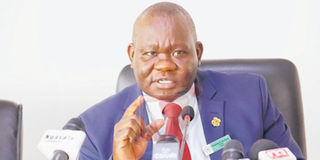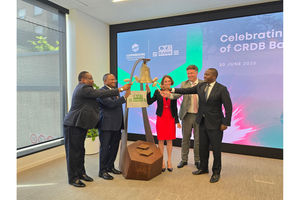Why public entities continue losing billions -CAG

Controller and Auditor General, Charles Kichere. PHOTO | ANTHONY SIAME
What you need to know:
The state power utility firm is also put on the CAG’s list of ‘bad boys, for ‘deliberately making its Customer Service Charter a secret to its own clients.
Dar es Salaam. Negligence, lack of knowledge and some regulatory failures are costing public entities dearly, with the latest audit report by the Controller and Auditor General (CAG) revealing how some state bodies lose billions despite having efficient control systems.
In his audits on a number of public entities for the 2018/19 financial year, the CAG specifically mentioned failure to utilize the installed control mechanisms and systems as well as deliberate move by some bodies to educate Tanzanians on some important projects as factors behind losses.
For instance, the CAG puts local government authorities on the spotlight for their failure to raise more money from internal sources and for setting unrealistic revenue projections.
This, the CAG blames on inadequate supervision, failure to collect revenues to the full potential of available sources and lack of effective strategies for expanding their tax bases.
The CAG also puts Tanzania Revenue Authority (TRA) and the Tanzania Communications Regulatory Authority (TCRA) on the attention of the public over the way the state institutions manage revenue collection from telecommunication companies.
Tanzania Electric Supply Company (Tanesco) is specifically put on the spotlight for losing an average of Sh67 billion per year due to power losses.
The state power utility firm is also put on the CAG’s list of ‘bad boys, for ‘deliberately making its Customer Service Charter a secret to its own clients.
TRA and TCRA
The two authorities are blamed for not ensuring effective collection of revenue from telecos service providers despite the fact that Tanzania established electronic systems for tracking revenue from the companies.
Tanzania installed two systems - Electronic Revenue Collection System (ERCS) and Telecommunications Revenue Assurance System (TRAS) - used to verify the correctness of tax returns submitted by telecommunication service providers but the Controller and Auditor General (CAG), Mr Charles Kichere, says operations of the TRA and TCRA are creating loopholes that would lead to loss of government revenues from the telcos.
Tanzanian telecommunication firms pay taxes like corporate tax, excise duty, value-added tax, payee tax and royalties to TRA. They also pay fees and penalties to the sector regulator TCRA.
“TRA did not effectively use ERCS to verify the tax,” stated the CAG adding that there was also an inadequate usage of TRAS by the taxman to verify the completeness of revenue and tax from telecommunication service providers.
The two systems are said to be reliable sources of information to verify the correctness of tax returns submitted by the telecoms.
TRAS was an infrastructure in Telecommunication Traffic Monitoring System (TTMS) aimed at providing revenue assurance services.
The implementation of TRAS was organized into two phases. Phase I included Vodacom, Airtel and MIC (T) from January 2018. Phase II comprised of TTC, Zantel, Viettel, Smart, Smile and SimbaNET from June 2018.
The report also says TRA did not sufficiently implement its responsibility of ensuring that tax audit was conducted to all telecoms.
For instance, while only four of the six firms were audited in 2015/16 and three in 2016/17, no company was audited in 2017/18 and only two in 2018/19.
“From this fact the audit team is of the view that once telecoms remained unaudited there is a risk of losing potential tax revenue,” the report stated.
The report also indicated that tax amount reported by ERCS differed from the tax amount recorded by the TRAS. The two electronic systems were supposed to provide the same results of the tax amount to be paid by telecommunication service providers because they all receive the same information.
The report states that TCRA and TRA have not effectively worked together to enhance collection of tax revenue from all telecoms using TRAS.
“Coordination between TRA and TCRA in sharing information that are likely to be the subject of abuse that affects taxations from telecommunication service providers was not adequate. To some extent, this was because of lack of leadership to coordinate information sharing between TRA and TCRA,” the report states.
Ewura
The CAG report indicates that there was a cumulative difference of 1.4 billion litres between the marked petroleum products and the total imported petroleum products for domestic use between 2015/2016 and 2018/2019.
The noted inconsistencies indicate weakness in monitoring petroleum products for domestic use which could result in revenue loss.
“I recommend that Ewura establishes a mechanism that would enable monitoring and reconciling of petroleum products for domestic use for proper management and control,” the report states.
Tanesco
In an audit on Tanesco, which also saw the auditors going to the Ministry of Energy and Ewura and to five regions of Dar es Salaam, Arusha, Mwanza, Mbeya and Dodoma, the CAG outlines how delay in completing surveys and connecting customers was costing the state power utility firm.
According to the CAG, the rule is that if one is to be connected through the existing infrastructure, actual connection has to be completed within 30 days from the time payments for the service is made.
If there is the requirement for a line extension, one must be connected within 60 days while if a new network is required to feed an industrial and commercial customer, electricity has to be supplied within 90 days of completing payments of the service line construction costs by the client.
Similarly, Tanesco’s own Customer Service Charter gives 7-14 days to provide a quotation to a customer who has filled in the Service Line Application Form and has provided all necessary attachments.
“Based on the reviewed Customer Service Report, we noted that, there were delays in conducting surveys and provision of quotation to customers. The longest recorded delays were up to three years. This means that, there were pending customers waiting for surveys since July 2016 (based on the scope of the audit),” the CAG says in its Performance audit report on the management of accessibility and reliability of electricity supply services
The report says that the number of conducted surveys rose from 223,876 in the financial year 2016/17 to 268,420 in the financial year 2018/19. It also says the number of surveys conducted on time also increased from 129,934 to 162,971 over the same period, noting however that though the rate of increase in the number of conducted surveys increased, but still the rate of surveys conducted on time never exceeded 61 percent.
“We noted that in total for Mainland Tanzania, there were 155,127 customers who paid monies to Tanesco for new service line connections since the financial year 2016/17 to January 2020 but they were still waiting for the connection service,” the audit reads.
Based on the analysis of balance of connection materials report, the common reason for fewer service line connection materials was Tanesco being unable to adequately establish the required materials; and to properly plan and manage the available materials, including poles, meters and Aerial Bundle Conductors (ABC).
If the customers had been aware of their rights as provided for under the Customer Service Charter, these delays would result into billions of shillings being paid to clients by Tanesco in compensations.
The failure to connect customers on time would cots Tanesco a whopping Sh12.23 billion if all customers decide to take action and demand compensation.
“Based on interviews with Tanesco officials, Tanesco, intentionally, did not raise awareness to customers on the availability of the compensation fund, as a result no affected customer ever filed claim,” the report reads.




